The Jet Age dawned for the western world in October 1958 with the introduction of both the Boeing 707 and the De Havilland Comet 4 (the first commercial jetliner—the Comet 1, introduced in 1952—suffered design problems and was withdrawn from service in 1954; the Soviets put the first successful jetliner into service – the Tupolev TU-104 – in 1956).
The Boeing 707 and the Comet 4 were followed by the Douglas DC-8, which flew its first commercial flights in September 1959. With their unprecedented speed and passenger capacity, jetliners carried the promise of a whole new era for commercial aviation.
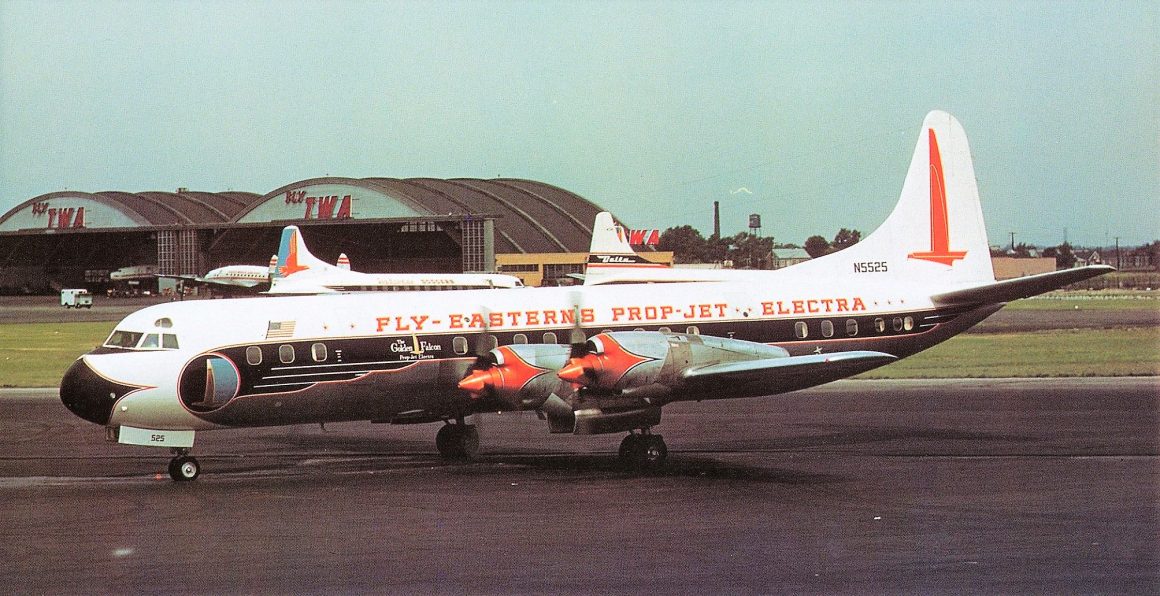
THE PROP-JET ELECTRA
Eastern Air Lines was a latecomer to the Jet Age. While rival airlines were deploying jets over Eastern’s most competitive routes during the winter of 1959-60, all of Eastern’s aircraft were propeller-driven. Captain Eddie Rickenbacker (referred to simply as “The Captain”) – Chairman of the Board and the force behind Eastern – had placed his faith in the turboprop Lockheed L-188 Electra, ordering 40 of them to operate Eastern’s premier services while other carriers broke in the jets. If the new jets suffered any problems, it would be other airlines that endured the bad publicity.
But it would be the Electras, not the new jetliners, that would generate negative attention. By mid-March 1960, three Electras in service with other airlines had crashed. Two of the accidents were attributed to a design flaw that could result in the separation of wing from fuselage. The Federal Aviation Administration (FAA) mandated that all Electras be flown at reduced speed until the flaw could be corrected. In the public’s eye, the type’s reputation was tarnished, and passengers began avoiding the Electra.

Then, on October 4, 1960, an Eastern Electra crashed within seconds after takeoff from Boston’s Logan Airport. The cause of the crash had nothing to do with the design flaw. The accident was the result of an ingestion of birds – starlings – into the engines. But the publicity did not help the reputations of either Eastern or the Electra.
EASTERN’S FIRST JETS
Rickenbacker had ordered 26 Douglas DC-8s (-21 models) for Eastern, but eventually scaled the order back to just 15. Eastern’s first jets did not enter scheduled service until January 24, 1960.
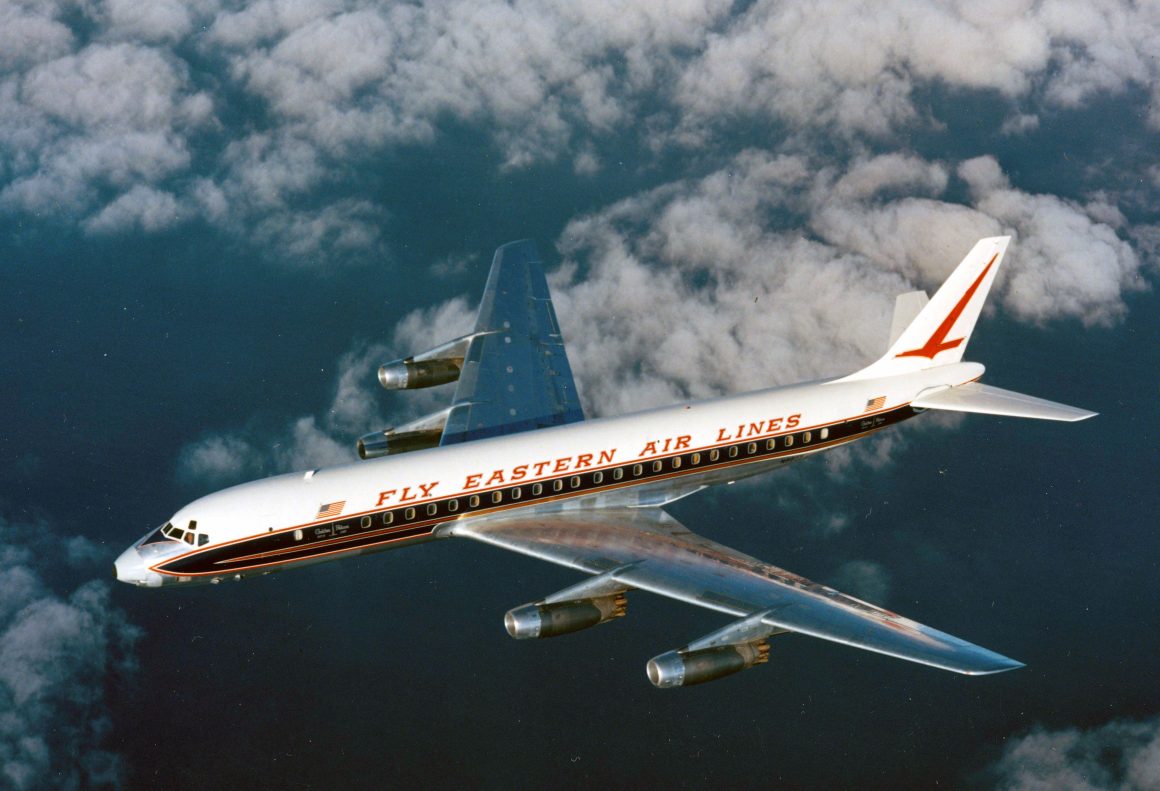
While Rickenbacker was still Chairman of the Board, Eastern’s President at the beginning of the 1960s was Malcolm MacIntyre, who insisted on operating free of The Captain’s control. But try as MacIntyre might, Rickenbacker still considered himself to be in charge.
Rickenbacker had promoted Eastern as a safe airline while other carriers advertised the quality of their service. Air safety greatly improved with the Jet Age. Because the CAB forced all airlines to charge the same fares, a carrier’s selling points would have to be service and convenience. In that regard, Eastern had an image problem.
In 1960, for the first time in 26 years, Eastern failed to post a profit.

THE AIR-SHUTTLE
The best thing to happen at Eastern in 1961 was the introduction of an experimental service in the Northeast Corridor (Washington-New York-Boston) called the Air-Shuttle. This new concept, approved by the CAB, allowed passengers to show up without reservations and purchase tickets on board. The clincher was that no one would be left behind; backup aircraft and standby crews would be available to operate an extra section whenever a scheduled flight reached capacity.

It took several months to fine-tune the Air-Shuttle, but it became a popular standard of travel. After only 14 months of operation, the Shuttle carried its one-millionth passenger.
MORE TROUBLES FOR EASTERN
Fifteen Boeing 720 jetliners began arriving on the property, the first entering service in August 1961. But despite the introduction of the Air-Shuttle and the transfer of several money-losing smaller stations to local airlines, Eastern posted a loss for the second year in a row.

In June 1962, the company suffered a 30-day Flight Engineers strike. It was the fourth strike against Eastern in five years.
Then, on November 30, 1962, an Eastern DC-7B crashed while attempting a go-around in fog at Idlewild Airport, killing 25 of the 51 people aboard.
1962 was the third year in a row for Eastern to post financial results in red ink.
THE CAPTAIN HAS TO GO
Eastern’s Board of Directors decided that change was needed at the top. It was time for The Captain to go. In December 1963, Malcolm MacIntyre left Eastern Air Lines and Eddie Rickenbacker retired. Floyd D. Hall, who had been recruited from TWA, took over as President and CEO of Eastern. He had a big task ahead of him.
Hall brought a fresh perspective to Eastern. He also brought in several new managers from outside the company—people who could bring fresh ideas and new energy to Eastern.
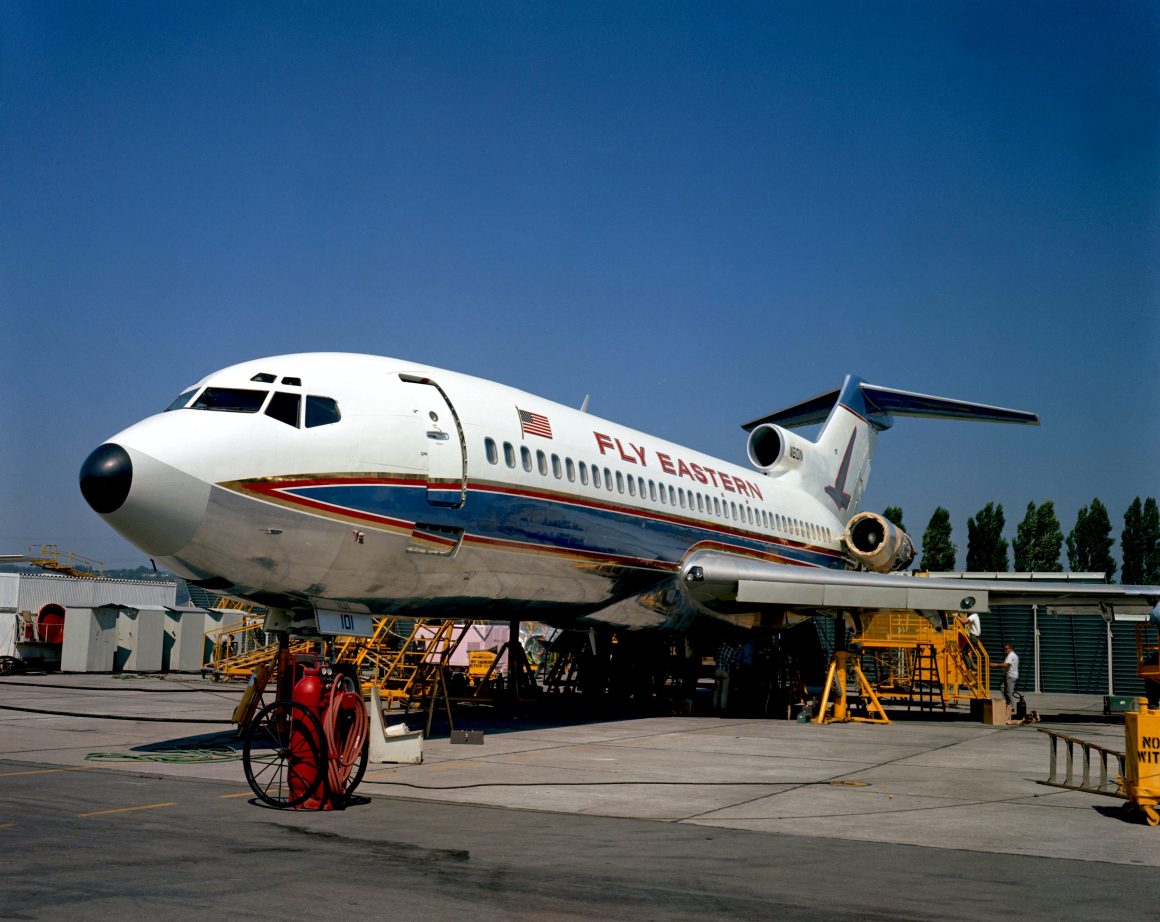
On February 1, 1964, Eastern’s employees took great pride in inauguration of the world’s first Boeing 727 service. The new tri-jet—designed for short and medium-haul segments—was a perfect fit for a network in which the average stage length was between 400 and 500 miles. Eastern christened its new birds Whisperjets.
Celebration of the new aircraft type was tempered by the tragic loss of one of the company’s DC-8s, which crashed into Lake Pontchartrain shortly after takeoff from New Orleans in the early morning darkness of February 25. There were no survivors.

A NEW SLOGAN AND A NEW LOOK FOR EASTERN
A new slogan, “See How Much Better An Airline Can Be”, was adopted, and along with the catchphrase came a new logo and aircraft livery. Referred to as the hockey stick paint scheme, the livery consisted of two stripes in different shades of blue running the length of the fuselage, then up at an angle to traverse the tail. The logo, a stylized falcon consisting of two white lines inside of a dark blue circle, was interpreted as the hockey puck.
Eastern’s management team devoted itself to improving the customer experience. One innovation for First Class passengers was the introduction of Famous Restaurant Flights, advertised as “a whole new approach to in-flight dining services.”
Eastern posted a profit in 1965 and again in 1966, despite a strike by the International Association of Machinists (IAM) that grounded five airlines – including Eastern – for 43 days that summer.

NEW JETS FOR SHORT AND LONG HAULS
For Eastern’s short-haul routes, Hall ordered 15 Douglas DC-9-14s, the first of which entered service in 1966. In 1967, Eastern became the first airline in the world to operate the stretch -30 series of the DC-9 (Eastern would eventually operate more than 70 of the type).
For long-hauls, Hall ordered stretch versions of the DC-8 (-61 and -63 models), the first of which also joined the fleet in 1967.
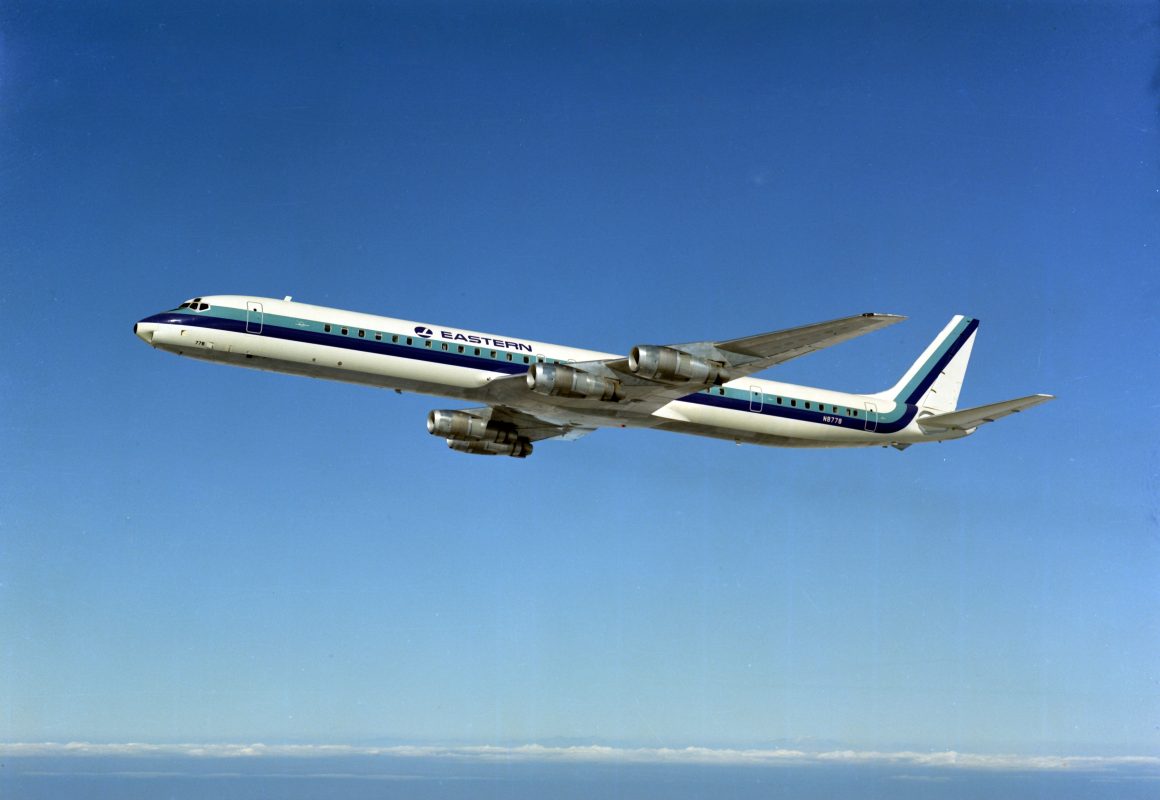
THE WINGS OF MAN
During the late 1960s, Young and Rubicam created several taglines for Eastern: “We Want Everyone to Fly,” “Number One to the Sun”, and the iconic slogan, “The Wings of Man.”
In 1966, the CAB approved Eastern’s acquisition of Mackey Airlines, which served the Bahamas from Florida. And, in 1967, the Civil Aeronautics Board gave Eastern a route to the West Coast: Melbourne/Cape Canaveral to Orlando, Huntsville, St. Louis, Portland and Seattle/Tacoma. This flight served the newly named Space Corridor, linking the Kennedy Space Center at Cape Canaveral with Redstone Arsenal in Huntsville and Boeing’s headquarters in Seattle.
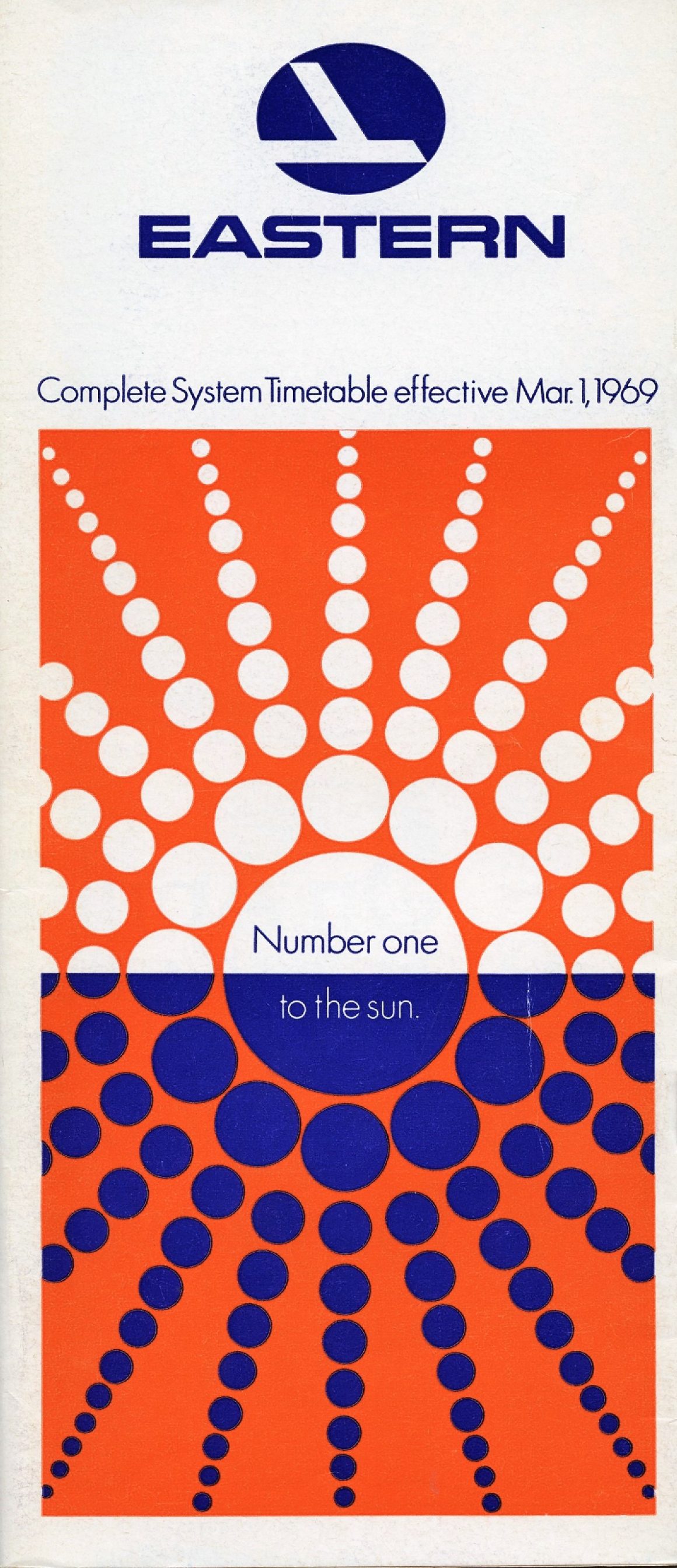
In preparation for the new era of jumbo jets, Eastern ordered four Boeing 747s for delivery in 1970, but sold all four to TWA before they were delivered. Eastern would, instead, lease three 747s from Pan Am while awaiting delivery of the wide-body jetliner it staked its future on — the Lockheed L-1011 TriStar.
Eastern Air Lines had made it through the tumultuous Sixties, and there would be more turbulence ahead in the 1970s. But the Wings of Man would navigate through the rough weather and survive another two decades.
